Canada Pavilion
Canada's pavilion faced Montreal on a site of 11 acres (30,285 sq. meters) at the upstream end of Ile Notre-Dame. Its 125 exhibits showed how the nation developed, the factors that shaped the lives of the Canadians, and what Canadians are like. Adjacent to it stood the pavilions of its various provinces.A huge inverted pyramid "the Katimavik" dominated the buildings of the Canadian Pavilion. It took its name from the Eskimo word for "gathering place", a reminder of Canada's role as host to millions of visitors from every part of the globe. Its other buildings, each with pyramidal roofs, held the exhibit areas. These areas were devoted to: The Land of Canada, The People of Canada, The Growth of Canada, The Challenges to Canadians and Canada and the World. There was also an Arts Center and a Children's Creative Center (ages 6-11).
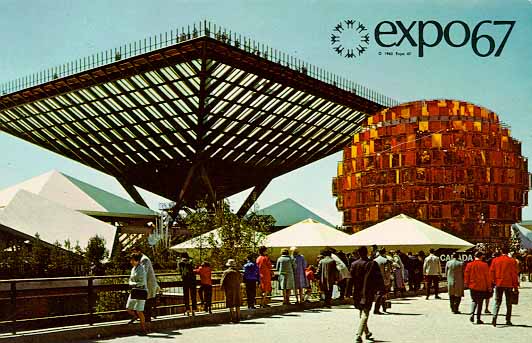
| Canada's dominant theme structures was the Katimavik, an inverted pyramid and the People Tree with its nylon transparent color images of Canadians. |
Visitors could climb onto the gigantic Katimavik via a series of stairs including the final open one that cut diagonally up to the topmost perimeter of the inverted pyramid (an elevator for the elderly and handicapped). Inside a display of unusual "sculptures" was fixed to the four sloping sides. Many of them moved while eerie electronic music accompanied the sculpture's movement in an odd dance of dance and movement. The hour glass tipped in the Time section and the Haida Indian mask in the Man section opened to reveal still another mask inside. The view of Expo from the Katimavik's 109 foot high top was spectacular. Below, beside the Katimavik was the six story high abstract People Tree. Its brilliant red and orange nylon "maple leaves" were actually hundreds of color photographs depicting Canadians at work and leisure. At night they turned incandescent under floodlights. Beneath the inverted pyramid was the immense Canadian display.
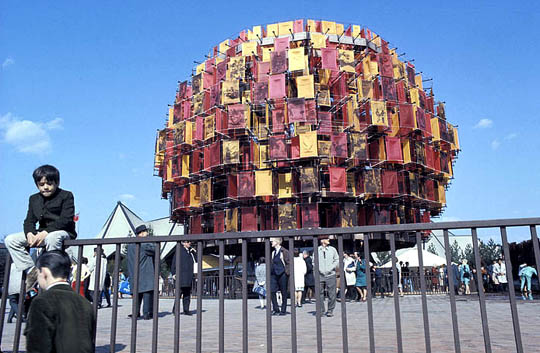
| The People Tree at the Canada Pavilion. |
In the Growth of Canada sector, photos and artifacts told the early history of the country, with a five-part film in a carousel theater, seating 1000 people every half hour, as its finale. Within the cinema, the seating sections circled clockwise from one theater to the next every four and one half minutes. First was a wide-screen color film that showed the wild and beautiful land that the explorers first encountered. The second theater, with two screens vertical and horizontal, showed a film "Settlement and Conflict" that recaptured the feeling of strife-torn early times. It was a time when a farmer plowing a field sometimes had to pick up a musket in alarm as sounds of gunfire reverberated in the woods nearby. The third film, an amusing cartoon, musically suggested how the Confederation occurred. The next theater was a big-screen sequence that showed the opening up of the West, the great migrations, the Gold Rush and the changes up to World War II. The final film in the last theater was an extremely modern, three screen film that offered images of today's Canada, both urban and industrialized, yet still dependent on the land.
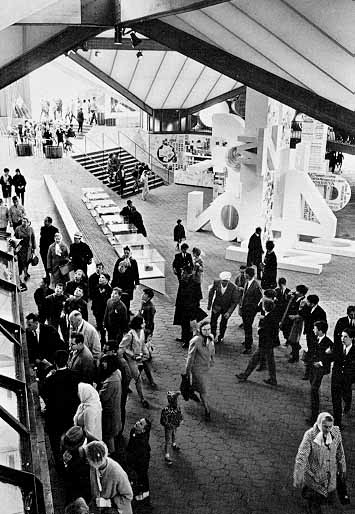 |
The Canadian pavilion's exhibit area. |
Resources and Energy was a huge space crammed with things to see and touch. One was able to walk through a simulated coal mine, see a monster map of Canada with geological specimens that corresponded to those found in each region. There was a giant waterfall to remind one how much Canada depends on water. And for atomic energy, there was a striking acrylic structure, 20 feet high and 30 feet across, representing the splitting of the atom.
The Transportation and Communications displayed a computer room operation, and there was a large Transportation "sculpture", made up of parts from various vehicles and engines. By pushing knobs one made an aircraft propeller whirl, or locomotive wheels turn. Upstairs in the building one could watch an animated film projected on four quadrants of a doomed ceiling. It depicted the growth of transportation and communication.
The Challenges to Canadians illustrated the response of Canadians to the factors of resources, distance, climate and topography. The emphasis was on energy as the means of using resources whether mining, agriculture or industry. A second portion covered the role of communication and transportation systems, while in a third, visitors faced personal challenges to greater achievement in work and recreation.
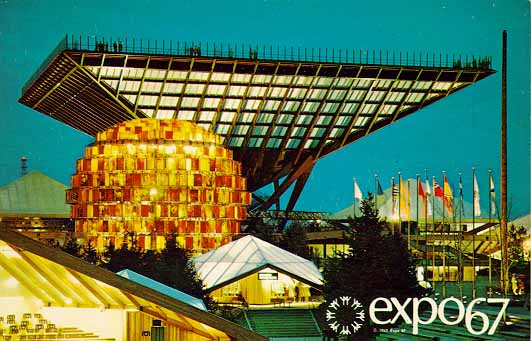 |
The Canadian pavilion at dusk. |
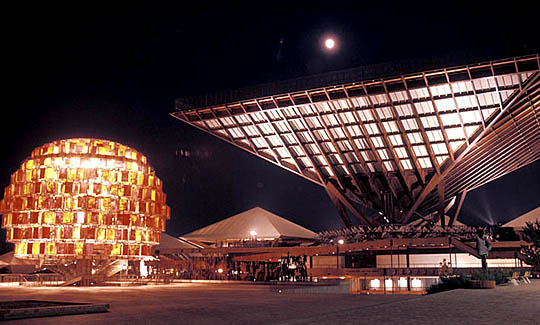
| Canada Pavilion at night. |